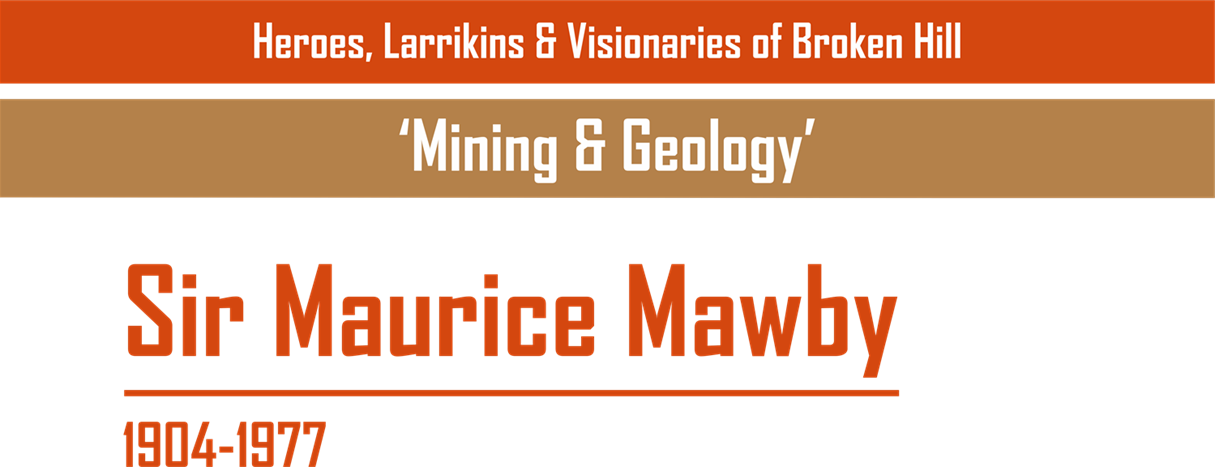Sir Maurice Mawby

Metallurgist, naturalist, geologist and industrialist, Maurice Mawby’s professional life was vibrant and far reaching. To the Barrier Field Naturalists Club he was first known as ‘the boy on the bicycle’ as he cycled around Broken Hill and to the outskirts of town collecting minerals and botanical specimens, and occasionally a rabbit for dinner. The natural world in all its beauty and diversity remained a passion for the rest of his life, even when he became an internationally known mining executive, whose work in mineral exploration and development put Australia on the map as a continent rich in natural resources.
Born in Broken Hill in 1904 to a British father, a grocer, and Australian mother, Maurice was educated at Broken Hill North Primary and Broken Hill High Schools before winning a scholarship to study at the local technical college. As his career in mining and mineralogy gathered momentum, he kept up his studies in the evening and was also part-time lecturing. He won the college bronze medal in 1934 after gaining diplomas in metallurgy and geology.
In the early 1920s, Maurice worked as a junior analyst on the investigation into the prevalence of lung disease and tuberculosis in miners working underground, then took a position as assayer and analyst for Junction North Mine, becoming the company metallurgist within two years. When the Junction Mine closed in 1928 Mawby went to work for the Zinc Corporation Ltd as a surveyor's assistant, responsible for designing underground timbering and mapping underground rail lines, expanding his knowledge and experience. He continued collecting, always, and of the 150 known minerals found in Broken Hill, he identified seventeen rare specimens.
Maurice married Broken Hill girl and long-time sweetheart Lena Lillian White in 1929 and, soon after, was promoted to mill foreman at the Zinc Corporation Ltd. In this new role, he demonstrated the same affection and concern for his colleagues and community as he had for the rocks and the soils. He witnessed the big strike while he was still in school and watched mounted police oppressing the striking miners in the streets of Broken Hill. He understood the problems of the miners and their families. When he met W.S. Robinson, a towering figure in the mining industry of the 1930s and war years, Mawby adopted Robinson's philosophy that ‘the prosperity of the mines was inextricably linked to the prosperity of the miners.
With Robinson’s backing, Maurice supported Broken Hill botanists Albert and Margaret Morris in the now-famous regeneration project which stabilised the soil of the surrounding desert and bush, preventing the devastating dust storms that had plagued the town since early mining operations stripped the landscape of trees. At the weekend, Maurice himself could be seen in the new green belt, digging holes and planting native shrubs.
Maurice Mawby’s brilliant career is too expansive to do justice to in summary, but here are some of its highlights: In 1939 he oversaw the commissioning of an innovative all-flotation plant for the separation of silver, lead, zinc, gold and copper from the Broken Hill ores. In 1942, Sydney Technical College awarded him a fellowship for his thesis on flotation process. and in the same year he was part of an Australian government mission to study metallurgical practices in North America, Canada and Mexico. He was appointed manager of New Broken Hill Consolidated/ Zinc Corporation Ltd in 1944.
In 1945 the Mawby family moved to Melbourne, but Maurice returned to Broken Hill in 1946 to rejoin the new Consolidated Zinc Corporation as director of exploration and research, becoming vice president in 1951 and chairman in 1955. In the same year he was awarded the degree of Doctor of Science of the New South Wales University of Technology.
In 1959 he was appointed C.B.E. and he was knighted in 1963. He strongly believed in keeping the control and development of Australia’s natural resources Australian, though in 1964 the American Institute of Mining, Metallurgical and Petroleum Engineers gave him honorary membership. In 1967 he became a founding member of the Australian Mining Industry Council.
Now Sir Maurice Mawby, he was elected a Fellow of the Australian Academy of Science in 1969. In 1970 he was awarded a Kernot Memorial Medal of the University of Melbourne.
On his retirement in 1974, Mawby said of his career and of Broken Hill: 'If I had my life to live again, I would wish no other than that which I have had in the same localities with the same people.’ Sir Maurice Mawby died in 1977 in Melbourne. The National Museum of Victoria acquired his collection of minerals.
Audio transcript available.
PICK UP YOUR FREE BROCHURE & MAP OF THIS TRAIL FROM THE VISITOR INFORMATION CENTRE